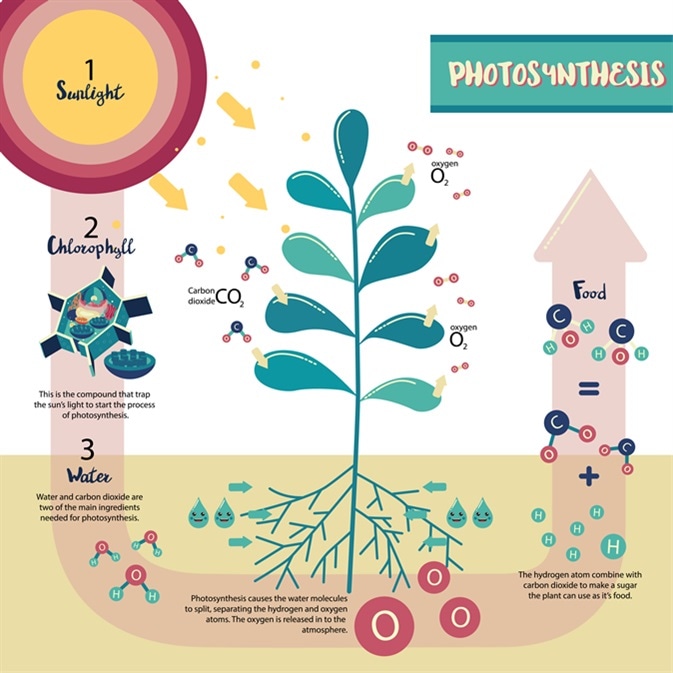What is Photosynthesis?

Photosynthesis is a chemical process by which plants, some bacteria, and algae convert energy derived from sunlight to chemical energy. This is an important process for biological life on earth because it allows energy from sunlight to be harnessed and transferred into a form that can be utilized by organisms to fuel their activity.

The energy from photosynthesis is stored within carbohydrate molecules, which can be kept within an organism until it is needed. The carbohydrate molecules can later be utilized as energy by the organism with a chemical process such as respiration, producing byproducts – carbon dioxide and water.
There are 2 types of photosynthe sis known as oxygenic and anoxygenic photosynthesis, depending on whether oxygen is produced in the reaction. Both these types will be covered in more detail below.
Oxygenic Photosynthesis
The most common type of photosynthesis is oxygenic photosynthesis, which is commonly seen in algae, plants, and cyanobacteria. In this process, energy from light is utilized to transfer electrons from H2O molecules to carbon dioxide (CO2). In this reaction, carbon dioxide is reduced because it receives electrons while water is oxidized because it loses electrons. As a result of the reaction, oxygen and carbohydrates are produced.
Oxygenic photosynthesis serves to balance the transfer of energy that occurs during the process of respiration. All living and breathing organisms inhale oxygen from the air to produce energy and exhale carbon dioxide into the atmosphere. Oxygenic photosynthesis replaces oxygen in the air with the assistance of energy from sunlight.
In the absence of oxygenic photosynthesis, atmospheric oxygen would eventually be depleted.
Oxygenic Photosynthesis Equation
Oxygenic photosynthesis is a complex process with multiple steps. However, the overall process can be summarized using the following chemical equation:
6CO2 + 12H2O + Light Energy à C6H12O6 + 6O2 + 6H2O
In the complete reaction, six carbon dioxide molecules combine with twelve molecules of water in the presence of sunlight, which provides the energy for the reaction to occur. As a result, a single glucose molecule, six oxygen molecules, and six molecules of water are formed.
Anoxygenic Photosynthesis
Anoxygenic photosynthesis utilizes electrons from molecules other than water to create chemical energy from light. This process usually happens in certain types of bacteria, as in, green sulfur bacteria and purple bacteria.
Importantly, oxygen is not produced during anoxygenic photosynthesis . The end product depends on the molecule that is the electron donor. As an example, bacteria may take the electrons from and oxidize a molecule such as hydrogen sulfide (H2S) to produce energy and solid sulfur (S) as a byproduct.
Anoxygenic Photosynthesis Equation
Similar to oxygenic photosynthesis, there is a complex process with multiple steps for anoxygenic photosynthesis, which can be summarized with the following chemical equation:
CO2 + 2H2A + Light Energy à CH2O + 2A + H2O
In this equation, “A” is a variable that may represent any element in the molecule of the electron donor. As an example, the ‘A’ may be the sulfur in the reaction to convert one molecule of carbon dioxide and two molecules of hydrogen sulfide into the end products.
References
- https://www.ncbi.nlm.nih.gov/pubmed/18468984
- https://www.ncbi.nlm.nih.gov/pmc/articles/PMC2606769/
- http://www.edinformatics.com/math_science/what_is_photosynthesis.htm
- https://www.youtube.com/watch?v=PABzqBjRHIg
Further Reading
- All Photosynthesis Content
Last Updated: Feb 26, 2019

Written by
Yolanda Smith
Yolanda graduated with a Bachelor of Pharmacy at the University of South Australia and has experience working in both Australia and Italy. She is passionate about how medicine, diet and lifestyle affect our health and enjoys helping people understand this. In her spare time she loves to explore the world and learn about new cultures and languages.
Source: Read Full Article